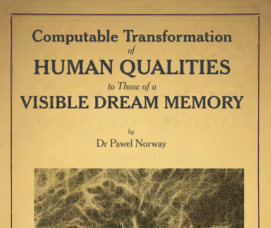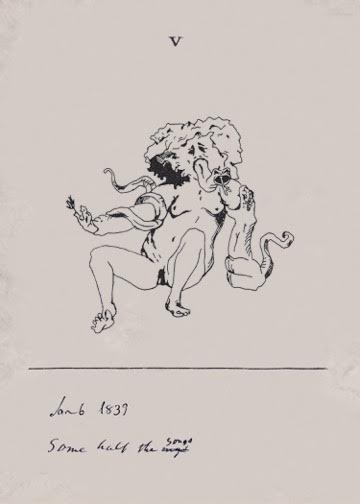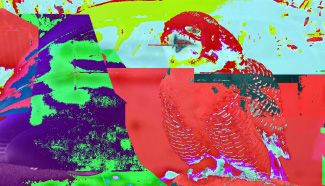IDEAS Event: The Pawel Norway Dream Machine |
||
|
||
|
DESCRIPTION/ABSTRACT: The IDEAS hybrid performance-exhibition in November will feature modern-day efforts to recreate experiments dating back to 1841 from Dr. Pawel Norway's treatise on Computable Transformation of Human Qualities to Those of a Visible Dream Memory. 
Dr. Norway's brief 1841 treatise is an obscure but intriguing thesis on the possibility of inferring dream content from the behavior of a subject after he or she has awakened. Developed over 100 years before the discovery of REM sleep, Computable Transformation argues that human bodies produce residual energy -- a type of Cartesian molecule -- that emits all day. The scientist believed that this energy can be collected and measured, including its velocity coming off the body, temperature, etc., which could make it possible to reconstruct the prior dreams. "We stumbled upon Computable Transformation deep in a small thrift store in Mangalia, Romania, and immediately identified analogues between Dr. Norway's work and the contemporary quantified-self movement," says Gabi Schaffzin, a second-year Ph.D. student of Art Practice in UC San Diego's Visual Arts department. "Both seek to infer a macro-level understanding of a body by measuring its micro-qualities." Dr. Norway, however, never fully implemented his theories, though he produced a number of etchings which sought to translate collected data points into imagery, or what are called scientific visualizations in modern parlance. 
For this performance-exhibition, the artists have recreated Dr. Norway's experiments to bring dream visualizations to the public. "Our technologically mediated society provides us with the sensorial and observational matrices necessary to measure -- and the computational power to visualize -- inferable data," explains Sofie Hodara, an artist, designer and educator (who previously was a supporting artist on Overheard, a 2009 gallery@calit2 exhibition by Wendy Richmond and Michael Chladli). "We have developed the apparatus of Pawel Norway's fantasies. It reads what our bodies say about our dreams (extracting imagery, narrative content, and subconscious meaning from the data) once we are awake, and doing so through high-sensitivity motion sensors, EEG readers, and sweat, temperature, and audio sensors." The output that makes up the bulk of the exhibition borrows from the quasi-representational nature of Dr. Norway's lithographs, though also incorporates the imagery and visuals produced and shared by the large swath of humanity living its lives on social-media outlets. "The result is an algorithmically-generated multimedia tapestry dynamically informed by the sensorial inputs we've combined," adds Zachary Kaiser, a professor of Graphic Design and Experience Architecture at Michigan State University. "We are now ready to present our findings alongside Dr. Norway's in a hybrid performance-exhibition installation in the Qualcomm Institute which will feature live dream-readings of volunteer visitors as well as Dr. Norway's work, with all the visuals on the Vroom display wall in the Calit2 Theater using the MUGIC system that has already been used for other IDEAS performances." The team of three artists, researchers and technologists previously performed large-scale installations of algorithmically-generated art, including the projection of 12 YouTube videos at a time on a 14-foot geodesic dome hoisted 20 feet in the air. They have also produced interactive experiences that convert kinetic movements into audio using Max/MSP, Pure Data, Processing, and Ableton Live. The artists noted that the project was completed, in part, thanks to support from the Arthur C. Clarke Center for Human Imagination. For more about the IDEAS Performance Series in the Qualcomm Institute, visit http://ideas.calit2.net/performances.php. SPEAKER BIO: GABI SCHAFFZIN is a second-year Ph.D. student in Art Practice in the UC San Diego Visual Arts department. His decade-plus of experience on the technology side of advertising has provided him the opportunity to hone his prototype and interaction development skills. His work has previously been installed in galleries and public spaces on campus, across the country, and internationally. He brings production- and teaching-level proficiency in OpenFrameworks, Processing, and other graphics-prototyping environments to the team. SOFIE HODARA is an artist, designer, and educator whose co-founding of the International Institute of Contemporary Art and Theory in Mangalia, Romania led to our discovery of Dr. Norway’s work. A formally-trained painter and printmaker, Hodara’s work has been exhibited across the country, including as a supporting artist in Wendy Richmond and Michael Chladli’s Winter 2010 Overheard exhibition in the gallery@calit2. During the pursuit of her MFA at the Massachusetts College of Art & Design (2014), Hodara explored the way our dynamic personal devices shape our perceptions of the world — a direction that provided her the opportunity to combine her formal training with prototyping technologies such as Pure Data (an open-source visual programming language developed by UCSD music professor Miller Puckette in the 1990s), Arduino, and Processing. She is now a professor of Graphic Design at Emmanuel College and the School of the Museum of Fine Arts in Boston, MA. ZACHARY KAISER is an educator who is always looking to combine his talents as a DJ and producer with his training as a graphic designer. As Assistant Professor of Graphic Design and Experience Architecture in the Department of Art, Art History, and Design at Michigan State University, he has been able to experiment in the classroom, the gallery, and through speaking engagements from Boston to Oslo to Mumbai. He is well-versed in Max/MSP (the Max computer music software environment was also written by UCSD's Miller Puckette), Arduino, and Processing and constantly infuses his work with questions about our technologically mediated culture. This is especially reflected in his MFA thesis, Towards a DJ Methodology of Learning (Massachusetts College of Art & Design, 2013). MORE INFORMATION: This IDEAS performance-exhibition are open to the public and admission is free. To reserve seats, please RSVP to Trish Stone at tstone@ucsd.edu. |


